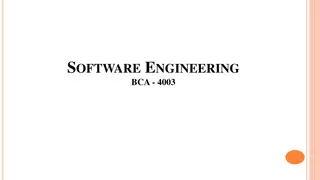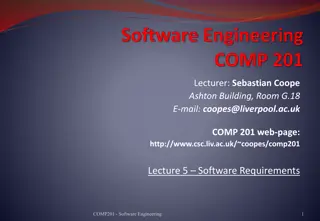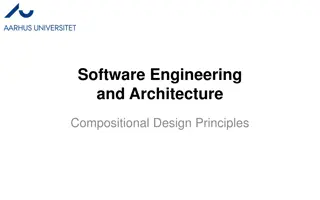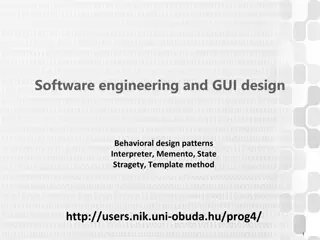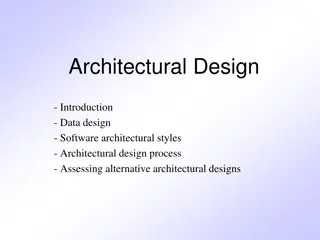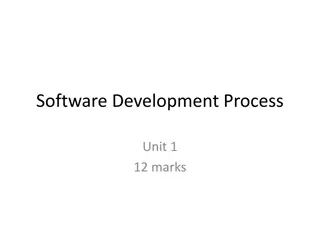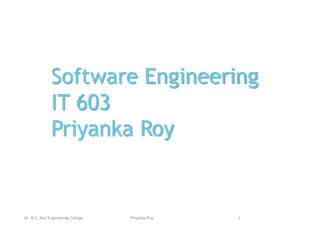Software Engineering Design Principles and Concepts
The chapter discusses the essential principles and concepts in software design, highlighting the four key design models - data design, architectural design, interface design, and component-level design. It emphasizes the importance of traceability to the analysis model, minimizing the gap between software and real-world problems, and the need for quality assessment during the design process. The text also covers fundamental design concepts that guide software engineers in navigating the design process effectively.
Download Presentation

Please find below an Image/Link to download the presentation.
The content on the website is provided AS IS for your information and personal use only. It may not be sold, licensed, or shared on other websites without obtaining consent from the author.If you encounter any issues during the download, it is possible that the publisher has removed the file from their server.
You are allowed to download the files provided on this website for personal or commercial use, subject to the condition that they are used lawfully. All files are the property of their respective owners.
The content on the website is provided AS IS for your information and personal use only. It may not be sold, licensed, or shared on other websites without obtaining consent from the author.
E N D
Presentation Transcript
Software engineering Software engineering Chapter 9 DEsign By: Lecturer By: Lecturer Raoof Raoof Talal Talal
9.1 Software Design The designer's goal is to produce a model or representation of an entity that will later be built. Each of the elements of the analysis model provides information that is necessary to create the four design models required for a complete specification of design. the design task produces the following four design models:
1-The data design: transforms the information domain model created during analysis into the data structures that will be required to implement the software. 2- The architectural design: defines the relationship between major structural elements of the software, the design patterns that can be used to achieve the requirements that have been defined for the system, and the constraints that affect the way in which architectural design patterns can be applied
3-The interface design: describes how the software communicates within itself, with systems that interoperate with it, and with humans who use it. 4-The component-level design: transforms structural elements of the software architecture into a procedural description of software components.
9.2 Design Principles Basic design principles enable the software engineer to navigate the design process. A set of principles for software design have been suggested, adapted and extended in the following list: 1- The design process should not suffer from tunnelvision. 2- The design should be traceable to the analysismodel. 3- The design should minimize the distance between the software and the problem as it exists in the real world.
4 The design should exhibit uniformity and integration. 5 The design should be structured to accommodate change. 6- Design is not coding, coding is notdesign. 7 The design should be assessed for quality as it is being created, not after the fact. 8 The design should be reviewed to minimize semantic errors.
9.3 Design Concepts A set of fundamental software design concepts has evolved over the past four decades. Each provides the software designer with a foundation from which more complicated design methods can be applied. Fundamental software design concepts provide the necessary framework for "getting it right."
9.3.1 Abstraction When we consider a modular solution to any problem, many levels of abstraction can be posed. At the highest level of abstraction, a solution is stated in broad terms using the language of the problem environment. At lower levels of abstraction, a more procedural orientation is taken. Finally, at the lowest level of abstraction, the solution is stated in a manner that can be directly implemented.
As we move through the design process, the level of abstraction is reduced. Finally, the lowest level of abstraction is reached when source code is generated.
9.3.2 Refinement A program is developed by successively refining levels of procedural detail. Refinement is actually a process of elaboration. We begin with a statement of function (or description of information) that is defined at a high level of abstraction. That is, the statement describes function or information conceptually but provides no information about the internal workings of the function or the internal structure of the information. Refinement
causes the designer to elaborate on the original statement, providing more and more detail as each successive refinement (elaboration) occurs. Abstraction and refinement are complementary concepts. Abstraction enables a designer to specify procedure and data and yet suppress low-level details. Refinement helps the designer to reveal low-level details as design progresses. Both concepts aid the designer in creating a complete design model as the design evolves.
9.3.3 Modularity The concept of modularity in computer software has been developed for almost five decades. Software architecture embodies modularity, that is, software is divided into separately named and addressable components, often called modules, which are integrated to satisfy problem requirements.
9.3.4 Software Architecture Software architecture refers to the hierarchical structure of program components (modules), the manner in which these components interact and the structure of data that are used by the components. In a broader sense, however, components can be generalized to represent major system elements and their interactions.
9.3.5 Control Hierarchy Control hierarchy, also called program structure, represents the organization of program components (modules) and implies a hierarchy of control. It does not represent procedural aspects of software such as sequence of processes, occurrence or order of decisions, or repetition of operations; nor is it necessarily applicable to all architectural styles.
Different notations are used to represent control hierarchy for those architectural styles that are amenable to this representation. The most common is the treelike diagram (Figure 9.1) that represents hierarchical control for call and return architectures. ch9-14
In order to facilitate discussions of structure, we define a few simple measures and terms. Referring to Figure 9.1: Depth and width: provide an indication of the number of levels of control and overall span of control, respectively. Fan-out: is a measure of the number of modules that are directly controlled by another module. Fan-in: indicates how many modules directly control a given module.
The control relationship among modules is expressed in the following way: A module that controls another module is said to be superordinate to it, and conversely, a module controlled by another is said to be subordinate to the controller. For example, referring to Figure 9.1, module M is superordinate to modules a, b, and c. Module h is subordinate to module e and is ultimately subordinate to module M.
9.3.6 Structural Partitioning If the architectural style of a system is hierarchical, the program structure can be partitioned both horizontally and vertically. Horizontal partitioning, (Figure 9.2a), Define separate branches of the modular hierarchy for each major program function. Control modules, represented in a darker shade are used to coordinate communication between and execution of the functions.
The simplest approach to horizontal partitioning defines three partitions input, data transformation (often called processing) and output. Partitioning the architecture horizontally provides a number of distinct benefits: software that is easier to test software that is easier to maintain propagation of fewer side effects software that is easier to extend
Vertical partitioning (Figure 9.2b), often called factoring, suggests that control (decision making) and work should be distributed top-down in the program structure. Top level modules should perform control functions and do little actual processing work. Modules that reside low in the structure should be the workers, performing all input, computation, and output tasks.
9.3.7 Data Structure Data structure is a representation of the logical relationship among individual elements of data. Because the structure of information will invariably affect the final procedural design, data structure is as important as program structure to the representation of software architecture.
The organization and complexity of a data structure are limited only by the skills of the designer. There are, however, a limited number of classic data structures that form the building blocks for more sophisticated structures.
A scalar item: is the simplest of all data structures. As its name implies, a scalar item represents a single element of information that may be addressed by an identifier; that is, access may be achieved by specifying a single address in memory. The size and format of a scalar item may vary within bounds that are dictated by a programming language. For example, a scalar item may be a logical entity one bit long, an integer or floating point number that is 8 to 64 bits long, or a character string that is hundreds or thousands of bytes long.
Sequential Vector: When scalar items are organized as a list or contiguous group, a sequential vector is formed. Vectors are the most common of all data structures and open the door to variable indexing of information. Matrix and array: When the sequential vector is extended to two, three, and ultimately, an arbitrary number of dimensions, an n-dimensional space is created. The most common n- dimensional space is the two-dimensional matrix. In many programming languages, an n-dimensional space is called an array.
A linked list: is a data structure that organizes noncontiguous scalar items, vectors, or spaces in a manner (called nodes) that enables them to be processed as a list. Each node contains the appropriate data organization (e.g., a vector) and one or more pointers that indicate the address in storage of the next node in the list. Nodes may be added at any point in the list by redefining pointers to accommodate the new list entry.
9.3.8 Software Procedure Program structure defines control hierarchy without regard to the sequence of processing and decisions. Software procedure focuses on the processing details of each module individually. Procedure must provide a precise specification of processing, including sequence of events, exact decision points, repetitive operations, and even data organization and structure.
There is, of course, a relationship between structure and procedure. The processing indicated for each module must include a reference to all modules subordinate to the module being described. That is, a procedural representation of software is layered as illustrated in Figure 9.3
9.3.9 Information Hiding The concept of modularity leads every software designer to a fundamental question: "How do we decompose a software solution to obtain the best set of modules?" The principle of information hiding suggests that modules be "characterized by design decisions that (each) hides from all others." In other words, modules should be specified and designed so that information (procedure and data) contained within a module is inaccessible to other modules that have no need for such information.
The use of information hiding as a design criterion for modular systems provides the greatest benefits when modifications are required during testing and later, during software maintenance. Because most data and procedure are hidden from other parts of the software, inadvertent errors introduced during modification are less likely to propagate to other locations within the software.
9.4 Object-Oriented Design In sections 9.1 to 9.3, the concept of a design for conventional software was introduced. Four design layers data, architectural, interface, and component level were defined and discussed. For object-oriented systems, we can also define a design layers, but the layers are a bit different. Referring to Figure 9.4, the four layers of the OO design pyramid are:
The subsystem layer: contains a representation of each of the subsystems that enable the software to achieve its customer- defined requirements and to implement the technical infrastructure that supports customer requirements. The class and object layer: contains the class hierarchies that enable the system to be created using generalizations and increasingly more targeted specializations. This layer also contains representations of each object.
The message layer: contains the design details that enable each object to communicate with its cooperators. This layer establishes the external and internal interfaces for the system. The responsibilities layer: contains the data structure and algorithmic design for all attributes and operations for each object.


